Store your air-dried fish in cool, dry areas like pantries or cupboards, maintaining temperatures between 59-70°F and humidity below 15%. You'll need airtight containers with secure seals or vacuum-sealed bags to protect against moisture and air exposure. Don't forget to add food-safe desiccant packets to control humidity, and keep containers away from heat sources, ovens, and windows. Label everything with storage dates and regularly check for quality through smell and appearance. When stored properly, air-dried fish can last several months at room temperature, though refrigeration works best for bulk quantities. Our detailed tips below will help you maximize your dried fish's shelf life.
Best Storage Locations
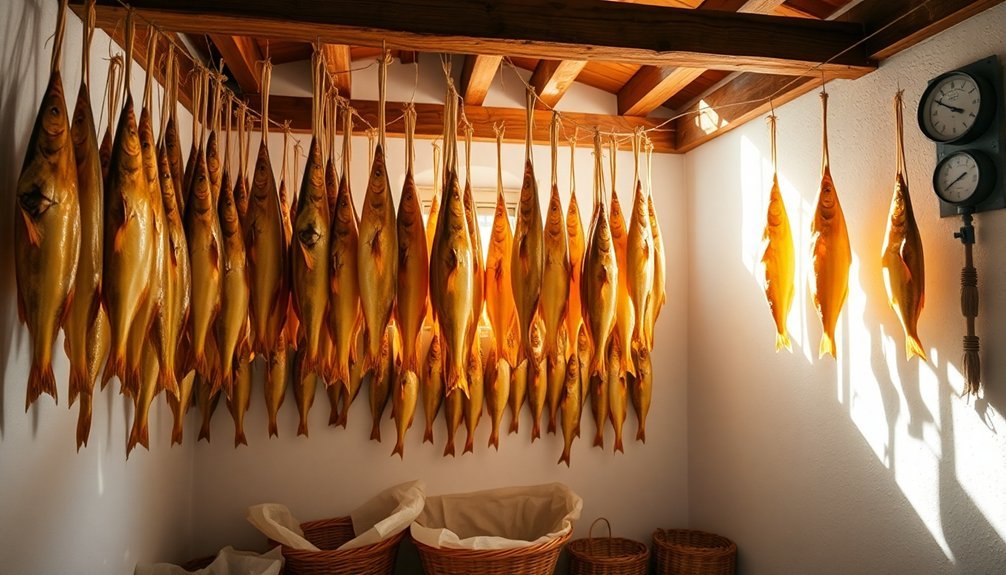
For ideal preservation of air-dried fish, store it in a cool, dry location like a pantry or cupboard that's away from direct sunlight and heat sources.
You'll want to avoid placing it near ovens, stoves, or windows, as these can alter both the texture and flavor of your dried fish. A clean, well-ventilated pantry that maintains a consistent temperature is perfect for this purpose.
If you have a basement or cellar that isn't prone to dampness, it can serve as an excellent storage spot. Using silica gel packets can help control moisture in high-humidity environments.
However, you'll need to make sure the area stays dry and pest-free. The ideal storage temperature should be between 10 and 15 degrees Celsius, with humidity levels kept below 15%.
You'll also want to protect your air-dried fish from UV rays, which can degrade its quality over time.
Consider using food-safe covers or packaging to shield your dried fish from light and heat exposure.
If you're storing a large quantity, it's crucial to maintain proper ventilation in your chosen storage area.
This helps regulate both temperature and humidity, preventing any unwanted moisture buildup that could lead to spoilage.
Selecting Proper Storage Containers
Select airtight containers made from durable materials like plastic or aluminum to protect your dried fish from moisture and contaminants.
You'll want to choose containers that feature smooth, dry surfaces for easy cleaning and proper sealing, with double-wall construction providing extra protection against temperature fluctuations. Triple wall interior containers made of polyethylene offer exceptional durability and low maintenance requirements.
Consider getting multiple smaller containers rather than one large one, as this lets you portion out your dried fish and minimize how often you expose the remaining supply to air.
Airtight Container Benefits
Proper storage containers stand out as one of the most essential elements in preserving air-dried fish. When you're using airtight containers, you'll protect your dried fish from its biggest enemies: moisture, oxygen, and heat.
These containers create a protective barrier that maintains the food's freshness and nutritional value while preventing contamination from external elements. Using glass jars or containers can be particularly effective for storing smaller portions of dried fish.
- You'll safeguard your dried fish from humidity and moisture absorption, which can lead to bacterial growth and spoilage.
- You'll block oxygen exposure that can cause the fish to become stale and lose its original texture.
- You'll protect against unwanted pests like pantry moths, flour mites, and ants.
Best Container Materials
Three main materials dominate the container market for storing air-dried fish: glass, plastic, and specialized storage containers. Each offers distinct advantages for your storage needs.
Glass containers provide excellent durability and won't absorb odors or stains from your dried fish. You'll appreciate that they're oven-safe and can shift from freezer to oven without issues.
However, they're heavier and more expensive than plastic options, and you'll need to handle them carefully to prevent breakage.
Plastic containers offer a lightweight, cost-effective solution. They're shatterproof and dishwasher-safe, making them convenient for daily use.
Keep in mind that they can retain odors and stains, especially those with high silicone content, and aren't suitable for oven use.
For professional-grade storage, consider specialized fish containers made from polyethylene. These double-walled, foam-filled containers provide superior temperature control and often include practical features like drain holes and stacking capabilities.
While they're primarily designed for industrial use, they're excellent for long-term storage. If you're concerned about moisture, look for containers with waterproof linings or those made from HD-polyethylene, which are specifically designed for freezing and stacking.
Size and Portioning Options
Understanding container sizes and portions helps you maximize storage efficiency for your air-dried fish. You'll need to match your storage needs with the right container size, from small 10-foot units holding 536 cubic feet to large 40-foot containers with 2,385 cubic feet of space.
- For small batches, choose 10-foot containers that can handle up to 19,530 pounds of dried fish, perfect for limited spaces and personal storage.
- Select 20-foot containers for medium-scale operations, offering 1,169 cubic feet with a 55,126-pound capacity.
- Opt for 40-foot containers when storing bulk quantities, with their impressive 61,200-pound payload capacity.
When portioning your dried fish, wrap individual pieces tightly in moisture-proof bags to maintain freshness. Don't let fish strips touch each other – use layers or separators to prevent moisture transfer and spoilage.
You'll want to label each container with storage dates and contents, making it easier to track your inventory and use older stock first.
Consider using high cube containers if you need extra height, as they provide additional vertical space for more efficient storage.
Remember to keep portions organized in airtight containers to prevent moisture intake and bacterial growth.
Temperature and Humidity Control
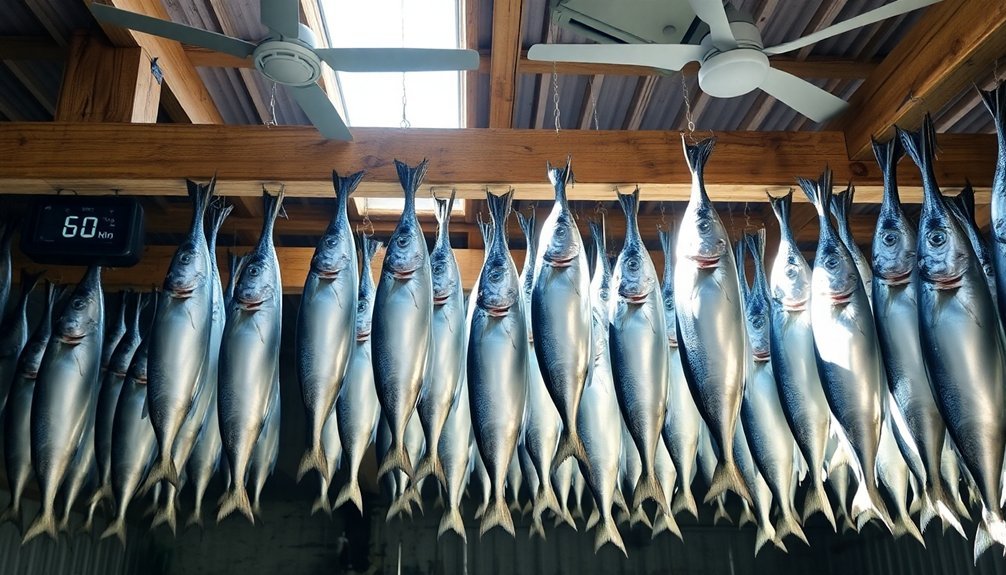
Store your air-dried fish in a cool, dry environment between 15-21°C (59-70°F) to maintain ideal preservation and prevent moisture absorption.
You'll need to monitor humidity levels regularly using a hygrometer, aiming to keep relative humidity below 65% to prevent spoilage and mold growth.
Consider installing a small dehumidifier or using silica gel packets in your storage area if you live in a particularly humid climate, as consistent environmental control is essential for long-term storage success.
Optimal Storage Temperature Range
Proper temperature control plays an essential role in preserving your air-dried fish. You'll want to maintain temperatures below 20°C (68°F) to prevent quality degradation and potential spoilage. For the best results, store your dried fish in an environment between 10°C to 15°C (50°F to 59°F), especially if you're planning for long-term storage.
Key temperature considerations for ideal storage:
- Never store your dried fish near direct sunlight or heat sources, as these can cause temperature fluctuations and accelerate spoilage.
- Monitor your storage area regularly to guarantee temperatures remain consistent and don't exceed recommended levels.
- Consider using a thermometer in your storage space to track temperature variations.
To maintain the perfect temperature range, you'll need to choose a storage location carefully. Cool basements, pantries, or dedicated storage rooms often provide suitable conditions.
If you're storing the fish in your kitchen, keep it away from your stove, oven, or other heat-generating appliances.
Remember that consistent temperature control isn't just about keeping the fish cool – it's about preventing temperature fluctuations that can affect the quality and shelf life of your dried fish.
Humidity Monitoring Methods
Along with temperature control, monitoring humidity levels gives you complete oversight of your air-dried fish storage conditions.
You'll need reliable monitoring tools to maintain ideal humidity levels between 40-60%, preventing microbial growth and preserving fish quality.
Install IoT-based systems with DHT sensors and microcontrollers for accurate measurements. You can monitor real-time data through applications like Blynk and Telegram, which will alert you when humidity levels fall outside acceptable ranges.
LED panels provide quick visual confirmation of current conditions, while Micro SD cards store historical data for analysis.
To maintain proper humidity, you'll need dehumidifiers that can effectively remove moisture from the air. Choose adsorption dehumidifiers for low-temperature environments, making sure they can lower the dew point to -15 to -20°C.
Position them to distribute dry air toward the ceiling for ideal coverage.
Regular maintenance is essential for accurate monitoring. Calibrate your devices frequently, and verify readings using multiple instruments like thermometers and digital data loggers.
Set up high temperature alarms and implement recording systems to track conditions over time. This thorough approach guarantees your air-dried fish remains in ideal condition throughout storage.
Environmental Control Systems
Effectively managing your storage facility's environment requires integrated control systems for both temperature and humidity. You'll need to maintain temperatures at or below 4°C for refrigerated storage, with fresh fish kept as close to 32°F as possible. Modern systems like the Randell FX Series can maintain precise temperatures without ice, while digital controls help you monitor and adjust settings as needed.
Key elements of environmental control include:
- Temperature management systems that adjust based on operational hours and processing stages, keeping processing areas between 8-12°C during activities like gutting and filleting.
- Humidity control mechanisms that maintain relative humidity below 45% while using low-velocity cooling to prevent product dehydration.
- Automated ventilation systems that quickly dry areas after washing and prevent moisture buildup during processing.
Your processing plant needs intelligent control systems that monitor and adjust both temperature and humidity based on indoor and outdoor conditions.
Install desiccant dehumidifiers and ventilation controls to maintain ideal air quality, and make sure your system can adapt to different processing stages. This thorough approach helps prevent contamination, extends product shelf life, and maintains the quality of your air-dried fish.
Packaging Materials and Methods
Selecting appropriate packaging materials and methods is essential for maintaining the quality of air-dried fish during storage. Modern plastic-based materials like low-density polythene and polypropylene offer affordable and accessible options for consumer packaging.
For better protection, consider polyester polyethylene laminated materials that effectively prevent moisture and gas exposure.
You'll want to avoid traditional packaging methods like hessian bags or palmyra leaf baskets, as they don't protect against moisture, oxygen, or insects. Instead, opt for vacuum packaging or modified atmosphere packaging (MAP) with 99.9% nitrogen, as these methods considerably reduce lipid oxidation and control microbial growth.
For bulk storage, use high-density polythene woven gusseted bags, which provide good tearing and bursting strength. If you're packaging for export, reinforce your containers with gunny fabric overwrap for long-distance transport.
Remember that your package closures must be free of defects to prevent moisture exposure, as dried fish is highly sensitive to humidity changes.
While wax-coated corrugated cartons and plywood boxes are options for bulk packaging, they may not offer complete protection against environmental factors and pests.
Air-Tight Container Solutions
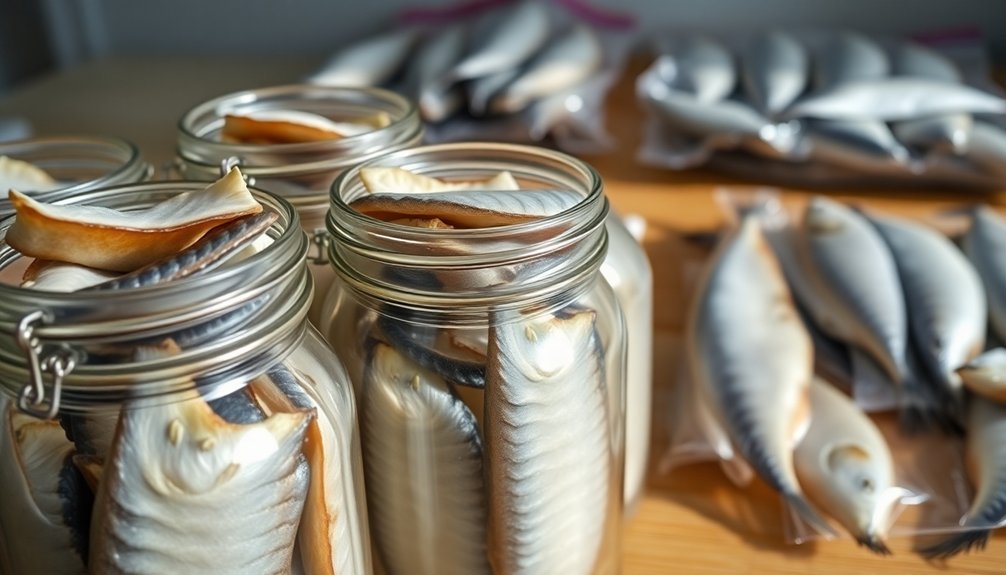
The right airtight container makes all the difference in preserving your air-dried fish. You'll want to select containers with tight-fitting lids or quality zip-lock freezer bags that let you force out excess air. Clean, dry containers are essential for maintaining the quality of your dried fish and preventing moisture from compromising its preservation.
- High-quality plastic freezer boxes with airtight seals provide excellent protection and are perfect for storing larger quantities.
- Resealable freezer bags work well for smaller portions and allow you to squeeze out excess air effectively.
- Storage containers with rubber gaskets or silicone seals offer superior protection against moisture and oxygen.
When you're choosing your container, make sure it's completely clean and dry before use. You can enhance protection by adding silica gel packets to absorb any residual moisture.
Don't forget to label your containers with storage dates to track freshness. If you're storing bulk quantities, keep them in the refrigerator and only remove what you'll need for immediate use.
Remember to handle the containers with dry hands and minimize how often you open them to maintain ideal preservation conditions.
Long-Term Storage Practices
For successful long-term fish storage, you'll need to maintain consistent temperatures in a cool, dry environment while using vacuum sealing to prevent oxidation.
You can enhance preservation by placing food-safe desiccant packets near your stored fish to absorb excess moisture, especially in humid conditions.
Your vacuum-sealed packages should be clearly labeled with dates and stored away from heat sources and direct sunlight to maximize shelf life and maintain quality.
Temperature Control Methods
Proper temperature control stands at the heart of successful long-term fish storage, whether you're freezing, refrigerating, or dry aging your catch.
For frozen storage, you'll need to maintain temperatures between -28°C to -18°C for oily fish and -20°C for lean fish. These temperatures effectively halt enzymatic degradation and microbial activity, ensuring your fish stays fresh for up to 12 months.
When refrigerating fish, keep temperatures around 0°C and maintain relative humidity between 90-95%. You can use ice to keep the fish moist and properly chilled during storage and transport.
For dry aging, you'll need precise temperature control combined with proper air circulation to prevent spoilage.
- Rapid freezing prevents large ice crystal formation, which can damage fish cell structure
- Core temperature measurement is essential – use a meat thermometer after drilling a small hole
- Water activity must stay at or below 0.85 for dried fish products to remain shelf-stable
Remember to regularly check your storage temperatures and maintain proper humidity levels.
For ultimate preservation, temperatures below -62°C will completely stop microbial decomposition, though this isn't typically necessary for home storage.
Your storage method should match your intended preservation timeline and the type of fish you're storing.
Vacuum Sealing Essentials
Successful vacuum sealing begins with thorough preparation of your fish and proper equipment setup. Start by cleaning and dressing your fish, then cut it into portions or fillets while removing all bones. You'll need to dry the fillets completely with paper towels and pre-freeze them for 1-2 hours to maintain their shape and moisture content.
When you're ready to seal, verify you're using vapor-proof packaging and avoid overfilling the bags. Lay the fish flat and maintain a dry sealing area to prevent seal failure. After sealing, store your fish at 0°F or below for ideal preservation.
| Process Step | Key Action | Duration/Temp |
|---|---|---|
| Preparation | Clean & portion | 15-20 mins |
| Pre-freezing | Firm up fish | 1-2 hours |
| Sealing | Remove air | 2-3 mins/piece |
| Storage | Freeze | 0°F or below |
| Thawing | Refrigerate | 8-12 hours |
Your vacuum-sealed fish can last up to two years when properly stored, though storage times vary by fish type. When it's time to use your fish, thaw it slowly in the refrigerator while keeping it in the sealed bag. Remember to blot it dry before cooking to verify the best results.
Desiccant Application Strategies
Beyond vacuum sealing, effective desiccant use plays a key role in maintaining the quality of air-dried fish during long-term storage. You'll need to select the right type of desiccant and implement proper placement strategies to guarantee ideal moisture control.
- Choose high-performance desiccants like calcium chloride or silica gel based on your specific storage needs.
- Position desiccant packets strategically throughout your storage container while avoiding direct contact with the fish.
- Monitor humidity levels regularly using hygrometers and replace saturated desiccants promptly.
For maximum effectiveness, place your desiccants in hanging bags or canisters to guarantee even distribution of their moisture-absorbing properties.
You'll want to maintain storage conditions with relative humidity below 50% and keep your dried fish in airtight containers away from direct sunlight and heat sources.
Don't forget to check your storage space regularly. Keep track of humidity levels, inspect your fish for any signs of rehydration, and maintain consistent temperature conditions to prevent condensation.
Moisture Prevention Techniques
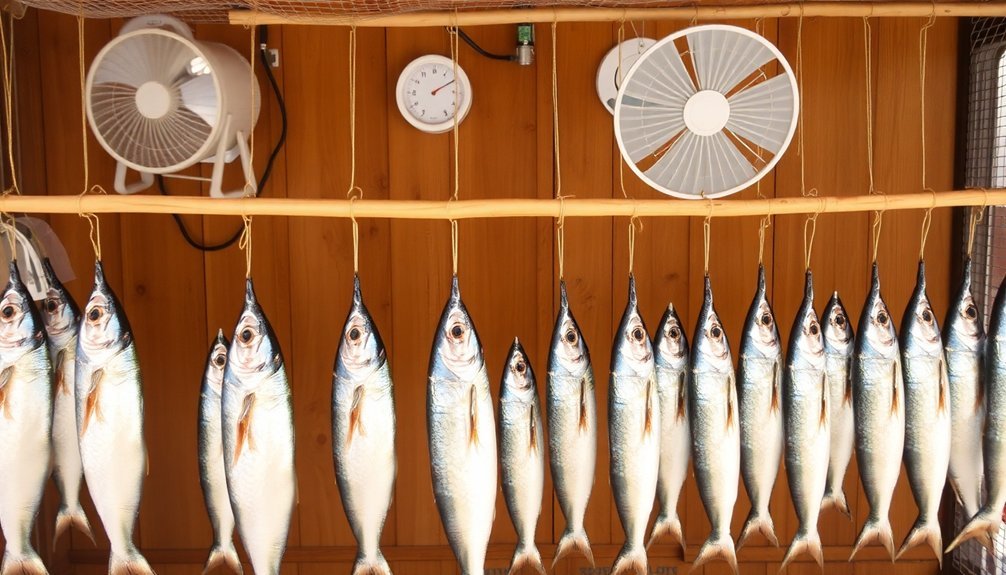
Maintaining strict moisture control stands as the cornerstone of preserving air-dried fish. To prevent moisture absorption, you'll need to keep the relative humidity below 75% in your storage area. Install dehumidifiers that can effectively remove moisture from the air and reduce the dew point to prevent condensation from forming on your dried fish.
Store your fish in a well-ventilated space using elevated drying racks to minimize ground moisture uptake. When humidity levels rise or during rainy periods, protect your dried fish with waterproof covers. Don't stack fish directly on top of each other; instead, use press-piling with weights to encourage moisture movement and maintain proper drying.
You'll want to maintain temperatures between 30-35°C while guaranteeing proper air circulation. This combination provides ideal drying conditions while preventing mold growth.
For long-term storage, use dehumidification systems that can handle seasonal changes and maintain consistent moisture levels. These systems should be capable of lowering the dew point to -15 to -20°C in cold storage areas.
Remember to monitor the water activity (Aw) level, keeping it at 0.85 or below to prevent bacterial growth and guarantee your dried fish remains safe for consumption.
Quality Inspection Guidelines
Regular quality inspections involve four critical components: sensory evaluation, defect detection, sampling procedures, and compliance verification. When checking your air-dried fish, you'll need to assess multiple factors to verify it's safe for consumption and storage.
- Conduct thorough sensory checks by examining the fish's odor (it should be light and characteristic, not acidic or ammonia-like), body rigidity (it should be firm), and surface appearance (look for bright coloring without blood spots).
- Inspect for critical defects by checking for foreign materials, persistent odd odors, and signs of dehydration or freezer burn that can't be removed without a knife.
- Evaluate the flesh quality by cutting around the neck area to check for decomposition and examine the abdominal cavity for holes or signs of enzymatic breakdown.
You'll want to cook a small sample to evaluate the flavor and texture after heating.
For proper compliance, verify your dried fish maintains a water activity level below 0.85 for shelf stability. If you notice any pink discoloration, halophilic mold, or intense bruising, these are signs of quality issues that need immediate attention.
Safe Handling Procedures
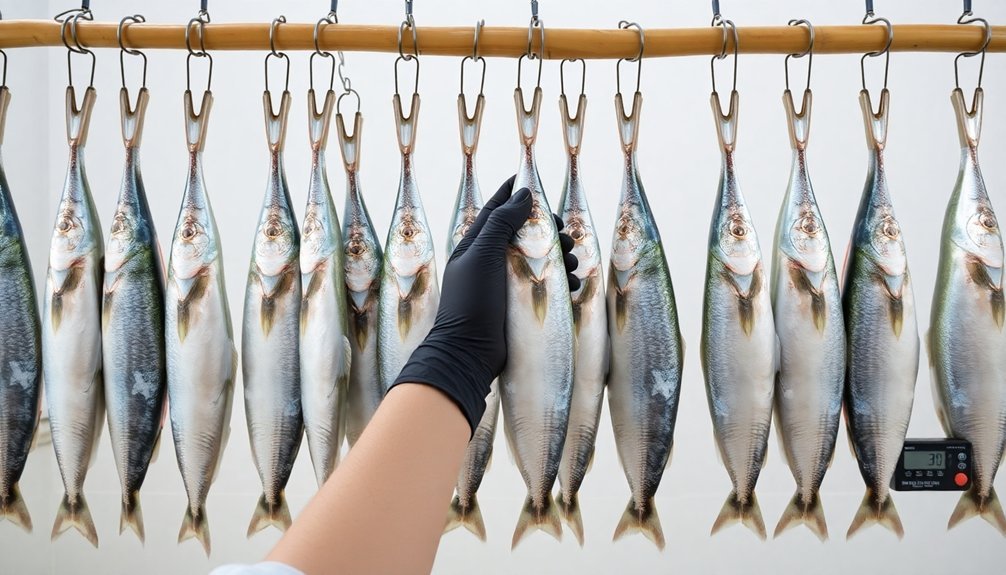
Safe handling starts with proper sanitation and careful attention to cross-contamination risks. You'll need to wash your hands thoroughly with hot, soapy water before and after handling raw or air-dried fish.
Clean all utensils, counters, and cutting boards that have touched raw fish with hot, soapy water, and don't reuse them for cooked foods without proper cleaning.
To prevent cross-contamination, keep raw fish separate from ready-to-eat foods during storage and preparation. Use dedicated cutting boards and utensils for raw fish, and store it in sealed containers at the bottom of your refrigerator to prevent juices from dripping onto other foods.
Don't place cooked foods on plates that previously held raw fish.
When packaging air-dried fish, use airtight containers or vacuum-sealed bags to prevent moisture infiltration. You can add desiccants like silica gel to absorb excess moisture.
Store your packaged fish in a cool, dry place away from sunlight and heat sources, such as ovens or windows. If you have a basement or cellar that's not prone to dampness, it can be ideal for long-term storage.
Remember to label and date containers to track freshness.
Storage Duration and Shelf Life
- Room temperature storage: Your air-dried fish will last several months when stored properly in airtight containers, but you'll need to consume opened packages within 1-2 weeks.
- Refrigerated storage: If you're storing bulk quantities, keep them in the fridge and remove only what you'll use weekly.
- Frozen storage: For maximum longevity, vacuum seal portions and freeze them, making sure to label packages with the date.
Monitor your stored fish regularly for signs of spoilage, and maintain consistent storage conditions to prevent quality degradation.
In humid environments, you can add desiccant packets to your storage containers to absorb excess moisture.
Remember that shelf life varies based on both production methods and storage conditions, so proper handling is essential for maintaining freshness.
Frequently Asked Questions
Can I Rehydrate Dried Fish, and How Does It Affect Storage Requirements?
Yes, you can rehydrate dried fish by soaking it in water for 2-4 hours. Once you've rehydrated fish, you'll need to store it in the refrigerator and consume it quickly, unlike dried fish's longer shelf life.
What Signs Indicate the Fish Was Improperly Dried Before Storage?
You'll notice improper drying through high moisture content, visible mold, off-colors, unpleasant smells, and soft/slimy texture. Watch for discoloration and check if it's too pliable when bent or squeezed.
Is Vacuum Sealing Necessary if I Plan to Use Within a Month?
While vacuum sealing isn't strictly necessary for one-month storage, you'll get better quality and freshness if you use it. It'll protect against freezer burn and help maintain the fish's flavor and texture.
Should Different Types of Dried Fish Be Stored Separately?
Yes, you'll want to store different types of dried fish separately to prevent flavor mixing and cross-contamination. This is especially important when storing strong-flavored fish like mackerel alongside milder varieties like cod.
Can I Store Dried Fish With Other Dried Foods Like Herbs?
No, you shouldn't store dried fish with herbs. Keep them separate in different airtight containers to prevent your herbs from absorbing the fish's strong odors, which would affect their quality and flavor.
In Summary
Store your air-dried fish correctly, and you'll enjoy its rich flavor for months to come. Remember to check regularly for signs of spoilage, maintain proper temperature and humidity levels, and use air-tight containers with moisture-absorbing packets. Don't forget to label everything with dates and rotate your stock. By following these storage guidelines, you're ensuring both safety and quality of your preserved fish.

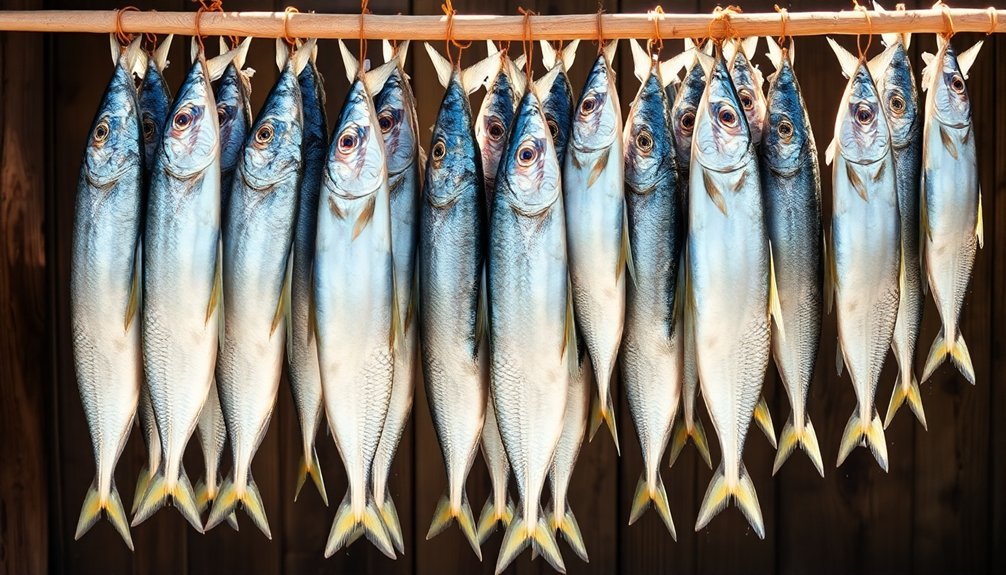



Leave a Reply